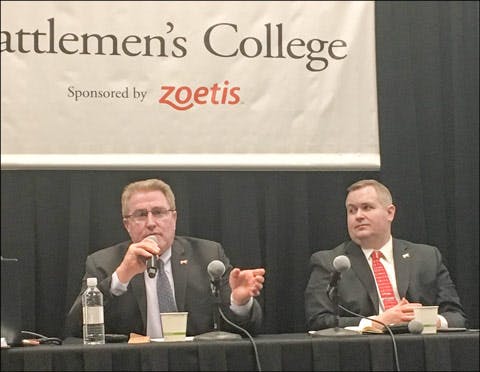Record Beef Exports Fuel Optimism at Cattle Industry Annual Convention
With U.S. beef exports expected to top $8 billion for the first time in 2018 and export value averaging more than $320 per head of fed slaughter, producers attending the 2019 Cattle Industry Annual Convention in New Orleans were eager to learn what the future holds for U.S. beef in the international marketplace. At Cattlemen’s College, a series of educational breakout sessions that opened the convention, USMEF President and CEO Dan Halstrom detailed the performance of several key export markets including Japan, South Korea, Mexico and Taiwan and discussed efforts to expand U.S. beef’s presence in emerging regions such as Africa.

USMEF President and CEO Dan Halstrom (left) and Kent Bacus, NCBA director of international trade and market access, lead an educational session on global beef trade at the Cattle Industry Annual Convention in New Orleans
“The key is really is to put the right cut in the right market to maximize value,” Halstrom explained. “For example, beef tongue to Japan, where yakiniku restaurants are a booming family-style dining segment, virtually every menu at these establishments has beef tongue as the first item. Consequently, the price of a beef tongue is more than $5 per pound. If you put all those tongues in the domestic market it would be well under $1 per pound. So that’s $12 per head in added value, just on a beef tongue.”
Halstrom was joined by Kent Bacus, director of international trade and market access for the National Cattlemen’s Beef Association (NCBA), who discussed the beef industry’s policy priorities and gave a status report on trade agreements and trade negotiations that help define the competitive landscape for U.S. beef. Halstrom and Bacus agreed that with competitors making market access gains in Japan through the Comprehensive and Progressive Agreement for Trans-Pacific Partnership, it is essential that upcoming negotiations between the U.S. and Japan make rapid progress.
Ratification of the recently negotiated U.S.-Mexico-Canada Agreement is also critical, so that U.S. beef can continue to enter Mexico and Canada duty-free. Mexico is the largest destination for U.S. beef variety meat and an important market for underutilized muscle cuts. When year-end 2018 data is available, U.S. beef and beef variety meat exports to Mexico are expected to exceed $1 billion for the first time since 2015. But Halstrom noted that the U.S. industry cannot take its position as Mexico’s leading beef supplier for granted.
“The U.S. is still the dominant player in the Mexican market,” Halstrom explained. “Earlier in this decade our market share was as high as 90 percent but in recent years, especially with the renegotiation of NAFTA, we’ve lost a few percentage points and now hold 83 percent of the market.”

USMEF Chairman Conley Nelson interviewed by Miranda Reiman of Certified Angus Beef® at the Cattle Industry Annual Convention
On Thursday, USMEF Vice President of International Marketing Programs Greg Hanes gave producers specific examples of how funding support from the Beef Checkoff Program is being utilized to expand global demand for U.S. beef. Hanes noted that checkoff-funded initiatives helped bolster South Korean consumers’ appetite for U.S. beef and the Korean market has become a tremendous driver of export growth. U.S. beef has also become more affordable in Korea due to declining tariff rates under the Korea-U.S. Free Trade Agreement.
“Korea is a market in which we have improved access over our competitors, and you can see how this enhances growth,” Hanes said. “If we can get similar terms in Japan and other markets, I think you would see similar growth in those areas as well.”
International trade was also a leading topic for U.S. Secretary of Agriculture Sonny Perdue, who addressed the convention Friday morning.
“When I talk with President Trump, he always asks me how the farmers are doing,” Perdue said. “And I say, ‘Mr. President, there are three things that farmers talk to me about all the time that are on the top of their list. Number one is trade, number two is trade and number three is trade. And trade is a close fourth, too.’”
Perdue noted that market access for U.S. beef was one of the main issues discussed in this week’s U.S.-China trade talks. He said he is also in frequent contact with the Office of the U.S. Trade Representative (USTR), and that USTR understands the urgency of the upcoming U.S.-Japan trade negotiations and their importance for U.S. agriculture.
On Friday afternoon, Halstrom, Hanes and USMEF Vice President for Industry Relations John Hinners will present detailed market updates to the Beef Checkoff Export Growth Committee. A recap of this committee meeting will be in next week’s Export Newsline.
USMEF Chairman Conley Nelson, a pork producer from Algona, Iowa, was a first-time attendee at the Cattle Industry Annual Convention, where he met with beef industry leaders and helped spread the word about the important returns red meat exports deliver for producers.
“Even with the challenges we are facing, producers remain optimistic about international trade and they understand the importance of exports to their bottom line,” Nelson said. “At an event like this it’s very gratifying to have them approach me, unsolicited, and tell me how pleased they are with the work of USMEF.”
